Planting and further care of the Ostrich fern
When decorating landscape design, zones for garden, vegetable and ornamental crops are determined. To make flower beds look expressive and bright, original plants are selected. One of the most popular is the fern. The article discusses the rules for planting the Ostrich variety and caring for it.
What is this plant
The representative of the Onokleev family is a perennial crop. Fern planting sites are selected in shaded corners of the site, under tall trees, near fences and other areas where it is harmoniously combined with other plants.
The ostrich is popular among gardeners for its unpretentious care, beautiful emerald foliage and high resistance to frost.
In nature, the plant lives in the temperate zone of Eurasia. It can be found in the forests of Russia, the Caucasus and other regions. The decorative qualities of the fern were appreciated by the designers, who, when decorating their private plots, often choose it to compose a composition.
Feature and Description
The plant reaches a height of up to 2 meters. The leaves are similar in shape to ostrich feathers, hence the name of the variety.
In botany, two types of fern leaves (frond) are described. Some are called sterile. The length of a feathery branch is 130-150 cm. The color is expressive emerald green. Thanks to the interesting shape of the frond, a beautiful crown is formed. The second type is spore-bearing, characterized by small-sized sheets of an unusual shape. They can be recognized by their brown color and the growth of branches from the inside of the funnel.
Bulky leaves of a sterile type at the initial stage of plant development are rolled up almost into a tube. When they reach a height of 30-50 cm, they gradually open. You can enjoy the aesthetic beauty of the culture in June. Having reached a large size, sterile leaves protect spore-bearing shoots from unfavorable atmospheric factors, the development of which occurs later.
Reference! In autumn, sterile leaves die off, and spore-bearing leaves remain on the plant all winter. In spring, when biological processes revive, overwintered branches unfold their edges and throw out spores.
Rapid reproduction of the Ostrich is noted in a vegetative way. Under favorable conditions, real thickets are formed from several bushes, which is more typical for a forest.
Views
Ostriches are of two types.
- Common is the most common. The fern grows quickly, tolerates wintering well. The peculiarity of the plant - it requires the implementation of certain rules of agricultural technology. The leaves are light green in color and wide feathery odors. Black areas may appear on the trunk and leaves.
- The eastern one is recognized by large branches that are neatly collected in bunches. Their length reaches one and a half meters. There is a brown film on the petioles. The leaves are characterized by a feathery shape (narrow feathers are twisted into a ball).
The differences between the species are in the care and the number of first-order leaves. Eastern fern requires more careful maintenance. Taken into account: regular watering, wind protection. The leaves of the first order in this form are smaller, but their size exceeds the shoots of the Common fern.
Differences between the Ostrich and other garden ferns
It is easy to confuse the ostrich with the Kochedzhniks and Shchitovniks. The only sure sign for identification is the height of the bush (1.5-2 m). It differs from other varieties in the shape of a bush. The branches are placed at the top of the rhizome in a circle. Shoots grow almost simultaneously.
The Ostrich has one more difference. By the end of the summer season, spore-bearing leaves appear on the plant. Outwardly, they are very similar to ostrich feathers. The twisted sporiferous slices are more like sausages. Sporos grow in the center of the funnel, reaching a length of no more than 50-60 cm.
Requirements for the conditions of detention
Common and Eastern ferns tolerate low temperatures well down to -10 °. If the region has more severe winters, the plants need shelter.
Culture does not tolerate heat. Already at an indicator above + 25 °, the leaves begin to wither and dry out. This is a characteristic feature of all ferns. Therefore, it is important in dry weather to regularly water the plants, including spraying from above. The soil must always remain moist.
Despite the unpretentiousness of the Ostrich, the plant needs the right choice of a place for planting and protection from the wind.
How to plant correctly
To make time for fern growing was not wasted, you need to familiarize yourself with the rules of its disembarkation and the features of further care.
Training
The place for the Ostrich is suitable both in dense shade and in a sunny meadow. The main requirement is a sufficient amount of moisture. On the sunny side, the bushes form slightly lower than when placed in the shade.
Before planting, the roots of the seedling must be soaked for 15-20 minutes in a solution of potassium permanganate (low concentration). This is done to disinfect the young shoot. Immediately before transferring the plant to open ground, the pot is lowered with it into a container of water. After the air bubbles come out, the pot is removed and the fern is carefully removed. You do not need to peel the root from the earth.
Reference! The planting area is determined taking into account the minimum distance of the fern to other plants. It is impossible to plant closer than 50 cm of culture.
The root of the fern quickly throws out shoots for reproduction. To prevent thickening of the planting, you should bury the restraints around the entire circumference of the bush. Any auxiliary material is used as a fence: plastic bottles, geotextiles, flexible curbs, etc. It must be deepened to a level of 30 cm below the ground surface.
The Ostrich is picky about soils. The plant grows on fertile and poor soils, prefers a slightly acidic or neutral environment. But sandy soil for a plant is not the best choice. On such a site, an automatic irrigation system is built, or the soil layer is replaced with a nutritious soil mixture of black soil, peat and humus.
Planting instructions
For planting on the site, seedlings are selected that have reached 2-3 years of age. If a voluminous composition is being built, it is worth choosing at least 5-7 shoots. However, it should be noted that the plant multiplies rapidly. An interval of 30 to 100 cm should be left between the bushes.
Designers use different forms of fern planting. An irregular triangle is considered the most attractive.
In a prepared place, a seedling is transferred to a moistened hole, the root is straightened and covered with prepared soil mixture. Florists recommend using nutritious soil so that the plant quickly adapts to new conditions.
Planting ends with irrigation. For irrigation, you need to take settled water with a temperature in the range of 17 ° - 22 °.
When growing fern in indoor conditions (in a pot) you can plan a landing at any time of the year.
Care
Despite the unpretentious care, the Ostrich reacts poorly to drought. On hot days, regular watering of the plant under the root and by spraying is ensured.Irrigation is carried out every other day or daily at stable high temperatures.
Important! Before watering, you need to check the condition of the soil. Too much moisture can trigger fungal infections.
Organic and mineral fertilizers are used as food. Preference is not given to a certain type of dressing, for the Ostrich it is not important.
Fern transplantation is usually planned in the spring after the plant has grown for more than 3 years in one place. At the end of the summer season, the site is changed using the maternal rhizome with a kidney.
There is no need to prune the fern bush. Once every 3 years, it is thinned to prevent strong thickening. It is for this reason that flower growers warn of restrictions on group planting.
The culture tolerates winter well due to its strong immunity and frost resistance. The root part of the bush is mulched with peat or other material. You can get by with simple hilling with soil.
Diseases and pests
One of the advantages of the Ostrich is the plant's high resistance to common diseases and pests.
Fight
Very rarely, bushes with feathery leaves are affected by infections and viruses, and suffer from insect infestations. The exceptions are slugs and snails. They can refuse greenery only if other succulent crops grow nearby.
Potential danger to the fern is also represented by: scale insects, spider mites, aphids. Therefore, the rules for caring for the plant provide for prophylactic treatments for the purpose of prophylaxis.
In the fight against parasites, the following means are used:
- Actellik solution 0.15% (1-2 ml are taken for 1 liter of water);
- Derris;
- Fitoverm;
- Intra-Vir;
- Decis.
A humid environment has a beneficial effect not only on the development of the fern, but also on fungal spores. The infection is recognized by reddish-brown spots on the leaves. To eliminate the disease, it is recommended to use any insecticide.
Prophylaxis
The main part of preventive measures is carried out in compliance with the rules of plant care. Weeding eliminates the thickening of the planting, ensures normal air circulation. This prevents the development of the fungus. For the same reason, it is necessary to periodically fluff the soil. First, oxygen is available to the fern roots. Secondly, weeds are removed.
To prevent yellowing of foliage and the formation of various defects on it, it is recommended to introduce top dressing 2-3 times per season. These can be compositions enriched with a mineral complex, or organic. In the spring, it is advisable to introduce nitrogen mixtures, in summer and autumn - potassium-phosphorus mixtures.
As additional activities, they carry out:
- spraying the bushes with infusions of aromatic herbs, garlic, onions;
- dusting with wood ash;
- processing with soapy water (laundry soap is used).
Reproduction
The ostrich reproduces in two ways.
- Vegetatively
This is done by dividing the bush. It is better to do this in early spring or late summer. A fragment of the rhizome is separated from the mother plant, which has 1 or 2 renewal buds.
- Disputes
Spores located on spore-bearing leaves remain viable for many years. They are sown in small containers filled with peat. Until the moment of germination, the litter is moistened. The seeding is stored under glass for about 3-5 weeks until shoots appear. After 2-3 weeks, the sprouts that appear dive into separate boxes, into which a mixture of peat, fertile soil and sand is poured.
The seedlings obtained from spores develop more intensively, have a strong immunity, which is expressed in resistance to diseases, parasites and an unfavorable environment.
Use in landscape design
As already noted, the fern is often used in landscape design.The plant looks original in a single and group planting, at the foot of a stone fence, among boulders. The ostrich is placed in the shaded corners of the site, on the northern slopes. Feather-leaved bushes decorate garden paths, driveways and flower beds.
Most often, fern is used when decorating the shores of an artificial reservoir, a garden fountain and other water bodies.
There is a place for the Ostrich and in the flower beds among the flowers of the following types:
- irises;
- peonies;
- delphiniums.
In shaded places, the fern looks harmoniously in combination with daylilies, hosts. It is worth composing it with other crops carefully, because the plant is capable of suppressing neighboring plantings.
In some cases, the fern is used as an object of camouflage to hide early blooming spring crops: daffodils, tulips, hazel grouses, and other bulbs. The dense greenery of the spreading leaves obscures the view of the fading plants, which by this time turn yellow and wither.
Important! When composing a flower garden composition, you need to take into account that the fern is rapidly increasing in size. A tall bush suppresses neighboring crops, which are later unrealistic to consider.
Spore-bearing leaves retain their aesthetic appearance for a long time. They are used by florists as dried flowers to compose original bouquets and flower arrangements.
Video about growing an ostrich in a garden plot:



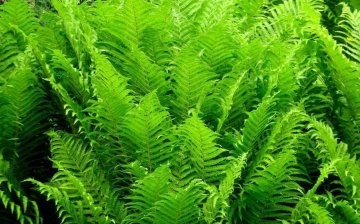
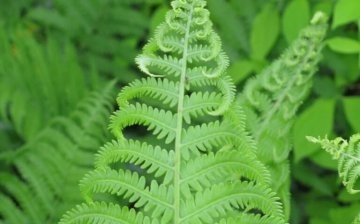
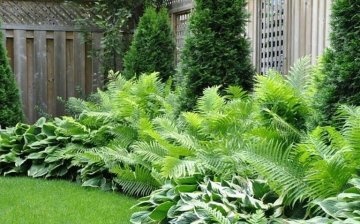



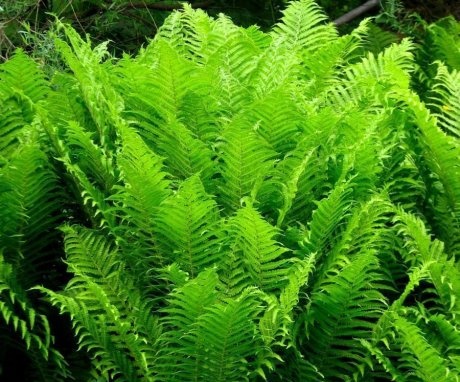
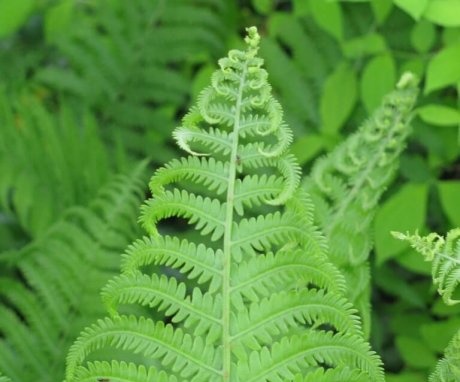

If the fern loves shaded areas, then, for the device of landscape design on the site, in the form of an alpine slide, it is definitely not suitable. Therefore, you can replace the fern with a juniper in the composition.